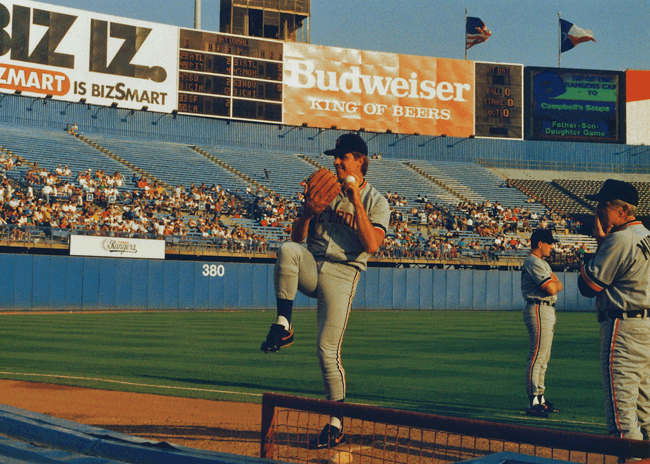The fondest memory most Detroit Tigers fans have of Frank Tanana is from the night he pitched the team to the 1987 American League East Division Championship. However, Tanana had a long and storied career before taking the mound for his hometown Tigers, including three All Star team selections, and a remarkable recovery from an injury that stripped most of the speed from his feared fastball.
If you want to watch Frank play ball these days, you’ll have to cheer along with his grandchildren as he takes the field for the Highland Park Baptist Church softball team. And, if you’re fortunate enough to speak with Frank before or after the game and ask him what it takes to be a great pitcher in the big leagues, he’s likely to tell you one of the following five things.
1. Throw A Lot
We live in an era where nearly all athletes are attempting to gain an advantage in their respective sports by engaging in some form of resistance training. However, in an era that preceded virtually all forms of weight training be Major League players, Frank had fastball that topped 100 miles per hour, and he developed it the old fashioned way; he threw hard, and he threw often.
“I know from my perspective, a lot muscles are developed from throwing,” Frank said. “Then with the use of your entire body to throw that hard, you really need to use your legs and work on your coordination, and you develop into a hard thrower. It’s not something that you just do. You have to develop and train, but I always did it by throwing a lot, and I was fortunate to have good mechanics and a real fluid delivery and follow through, and I was just able to develop and have a strong body.”
2. Take Time Off For Other Sports
Sports specialization is encouraged by coaches of nearly all sports under the assumption that playing and practicing a single sport all year yields greater performance benefits than doing so only seasonally. However, the mechanics of pitching are very unique and heavily taxing to the body, so Frank encourages participation in other sports as a means of giving a pitcher some time to recuperate.
“My recommendation would be that pitchers play in the spring and play in the summer, but let the arm rest in the fall and winter,” Frank advised. “They should play other sports to diversify themselves and enjoy. A lot of kids pitch year round, and I don’t see that as being good for pitchers’ arms. Nothing beats practice and throwing and playing, but the body needs rest. We went hard for five months and then played other sports, so we weren’t doing that unnatural throwing motion all year round. If you do that, you’re giving your body a chance to develop and then rest.”
3. Work Your Legs
When assessing pitching power, all of the emphasis is usually given to a pitcher’s arm strength. Surprisingly, less attention is paid to other extremities, the legs, which are responsible for generating a great deal of the torque involved in the pitching motion. In fact, when Frank talks about pitching power, the discussion of strength begins and ends with the legs.
“If you’re pitching and you’re going through the pitching motion, your legs are your base and your solid foundation,” Frank said. “You’re driving off one leg and landing on another. Without strong legs, any athlete really goes nowhere, but this is especially true of a pitcher. Your legs are going to help carry and alleviate some of the stress as you drive toward the plate, and your legs also need to be strong to help the arm and take the pressure off of it. Remember, you’re not an arm thrower; you’re a full body thrower. That sort of leg strength comes from things like cycling and running, or simply from being active.”
4. Develop Total Control
In the context of pitching, power is meaningless if you can’t get the ball over the plate. By the same token, a lack of velocity doesn’t mean you can’t be a standout on the mound; you simply need mastery over the flight of the ball. Rather than relying simply on speed to get batters out, Frank varied his deliveries to the plate in order to keep batters guessing.
“I’d just go into practice and experiment with different speeds and arm angles to give hitters different looks,” Frank explained. “I’d just say ‘let’s try this or let’s try that,’ and then throw a sidearm pitch or throw an overhand pitch. It was really trial and error. I was out there just trying different things and learning how to get comfortable. Everything I did was really built around a fastball, a curve and then just changing speeds.”
5. Work Your Way Through Trouble
One of the unique features of Frank’s baseball career was his recovery from the loss of his high-speed fastball, which would be a crippling blow to most professional baseball pitchers. Despite his injury, he stretched his baseball career to 21 years through reinventing himself as a finesse pitcher. Frank lengthy tenure in the Majors serves as yet another example of how limitations can be overcome if athletes are willing to work around them.
“The pitchers that can adapt last a little bit longer, and the ones that don’t will be out of baseball,” Frank warned. “It’s a case-by-case basis. What I was able to do is not common at all in baseball. For someone to go from being a hard thrower to a finesse pitcher doesn’t happen that often. It came from working hard doing more things than I did when I simply threw hard.”
The Meijer State Games of Michigan is a multi-sport, Olympic-style event(s) that welcome athletes regardless of age or ability level. The Games embody the values of participation, sportsmanship and healthy living.
Interested in our Summer Games?
www.StateGamesofMichigan.com/summergames
Interested in our Winter Games?
www.StateGamesofMichigan.com/wintergames







